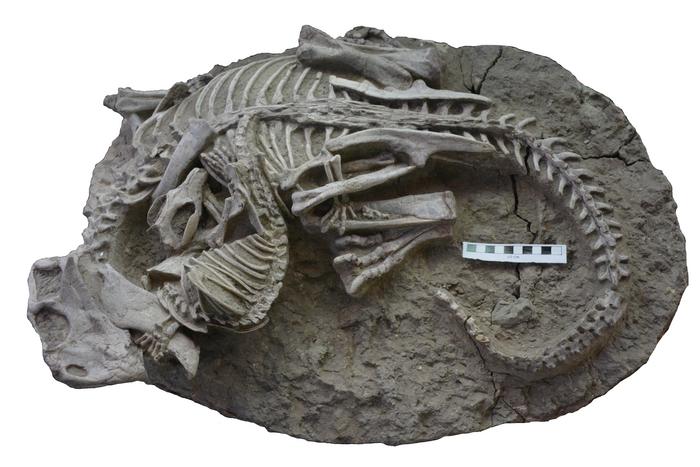Ferocious, Badger-Like Animal Once Attacked and Killed Dinosaurs
Posted on Categories Discover Magazine

A new fossil discovery bolsters an idea first proposed in 2005: Early mammals that lived during the Cretaceous Period were not just shrinking violets, little shrews hiding in the shadows of dinosaurs. As the new thinking goes, some of the mammals were predators themselves that attacked and ate small dinosaurs and their young.
The new fossil from China shows a small, badger-like predator, a Repenomamus robustus, on top of a Psittacosaurus, a beaked herbivorous dinosaur about the size of a large dog. The mammal grips the dinosaur with its left paw while curling to the right and biting into the reptile’s ribs in a dramatic embrace. It’s so dramatic, in fact, that researchers say the dinosaur was likely alive at the time and not yet deceased.
“The weight of the evidence suggests that an active attack was underway,” said Jordan Mallon, a paleobiologist with the Canadian Museum of Nature, in a statement.
Diorama of Death
Both skeletons that make up the fossil are in remarkable shape and nearly complete. Scientists collected the dramatic scene, a diorama of death, from China’s Liaoning Province in 2012 from the country’s “Dinosaur Pompeii.” The area contains many dinosaurs, small mammals, lizards and amphibians buried by mudslides and other debris that fell during volcanic eruptions.
“The co-existence of these two animals is not new, but what’s new to science through this amazing fossil is the predatory behavior it shows,” says Mallon.
The fossil came to light when one of the co-authors, paleontologist Gang Han from China, sent it to Xiao-Chun Wu, a paleobiologist at the Canadian Museum of Nature. They pulled together a team of Canadian and Chinese scientists who dated the bones to 125 million years ago, when dinosaurs dominated the earth.
An artist’s rendering of the fatal encounter. (Credit: Michael Skrepnick)
Did Mammals Compete With Dinosaurs?
In 2005, paleontologists reported the discovery of an R. robustus fossil that contained the bones of a baby dinosaur, shaking old assumptions about early mammals. The juvenile Psittacosaurus measured about 5 inches and appeared to have been dismembered and wolfed down rapidly. Like the later fossils, these came from northeastern China and dated to roughly the same time, 130 million years ago.
An even more dangerous species of Repenomamus walked the same ground as the dinosaurs. The coyote-size R. giganticus “was probably competing with carnivorous dinosaurs for food and territory,” researcher Yaoming Hu told Science.
Modern analogies abound of small predators attacking larger prey, from wolverines tackling sheep to coyotes killing deer and even buffalo. Analogies also exist of predators eating their prey while they’re still alive, which is what the researchers suggest was preserved in the new fossil.
“This might be the case of what’s depicted,” says Mallon, “with the Repenomamus actually eating the Psittacosaurus while it was still alive – before both were killed in the roily aftermath.”
Read More: Did Humans and Dinosaurs Ever Live Together?